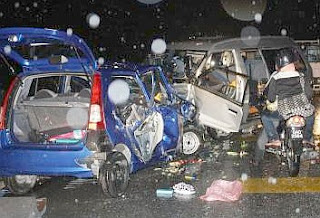70 CAR OF MIX VARIANCES IN MALAYSIA FAILED THE NCAP CRASH TEST?
The essence behind the NCAP
is to educate consumers in selecting the best crashworthy car.
Well.. It would have if it was made to go through the crash test but instead, it was given an exemption from compliance by our Ministry of Transport.
On 7 December 2011, the Global New Car Assessment Programme (GNCAP) and the Malaysian Institute of Road Safety Research (MIROS) signed a collaborative MOU to establish a pilot project for an ASEAN
(Association of Southeast Asian Nation) New Car Assessment Program (NCAP). The objective of the program was to
elevate motor vehicle safety standards in the ASEAN region and encourage
a market for safer vehicles. (Source: FIA).
Upon getting the cabinet approval, the Transport Ministry issued a list of
United Nation Economic Council for Europe (UN ECE) regulations for motorcar assemblers and manufacturers in
Malaysia to implement by January 2012. Failing that, the Ministry of
Transport (MOT) had already extended the date by six months
to June 2012. (Source: New Sunday Times, 13 April 2012)
Todate, 10 car-make with 70 model variances listed below still did not meet the regulation under the ASEAN NCAP. Those listed below did not comply and was given an exemption from complying to the UN ECE Regulation 94 and R95. (Source: Road Transport Department (JPJ), website).
The UN ECE Regulation No. 94 and No. 95 specifies a minimum crash safety performance for frontal collision speed of 64 km/h and side collision speed of 64 km/h.
The UN ECE Regulation No. 94 and No. 95 specifies a minimum crash safety performance for frontal collision speed of 64 km/h and side collision speed of 64 km/h.
Notice from the list below, most global carmaker such as TOYOTA, produced two different models of the same car with those in Malaysia not conforming to the Global crashworthiness standard but the same car passed the carshworthiness in other region.
A global car manufacturer has to engineer the car to four different types of national specifications but usually it was designed in compliance to either the US specifications or the General Market specifications. There are also the European specifications and Japan specifications. The US specification is usually the most expensive because of the high safety and environmental specifications.
A global car manufacturer has to engineer the car to four different types of national specifications but usually it was designed in compliance to either the US specifications or the General Market specifications. There are also the European specifications and Japan specifications. The US specification is usually the most expensive because of the high safety and environmental specifications.
 |
| (Source: Road Transport Department (JPJ), website) |















































